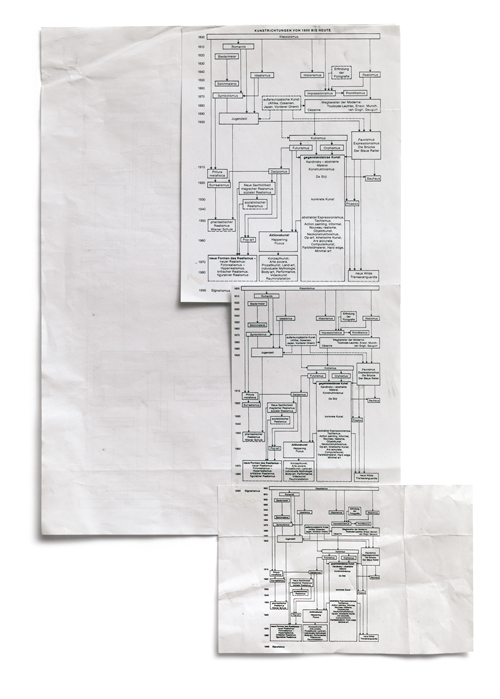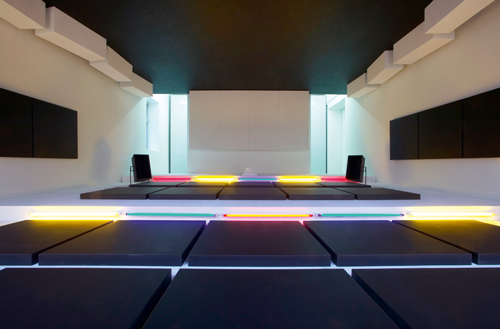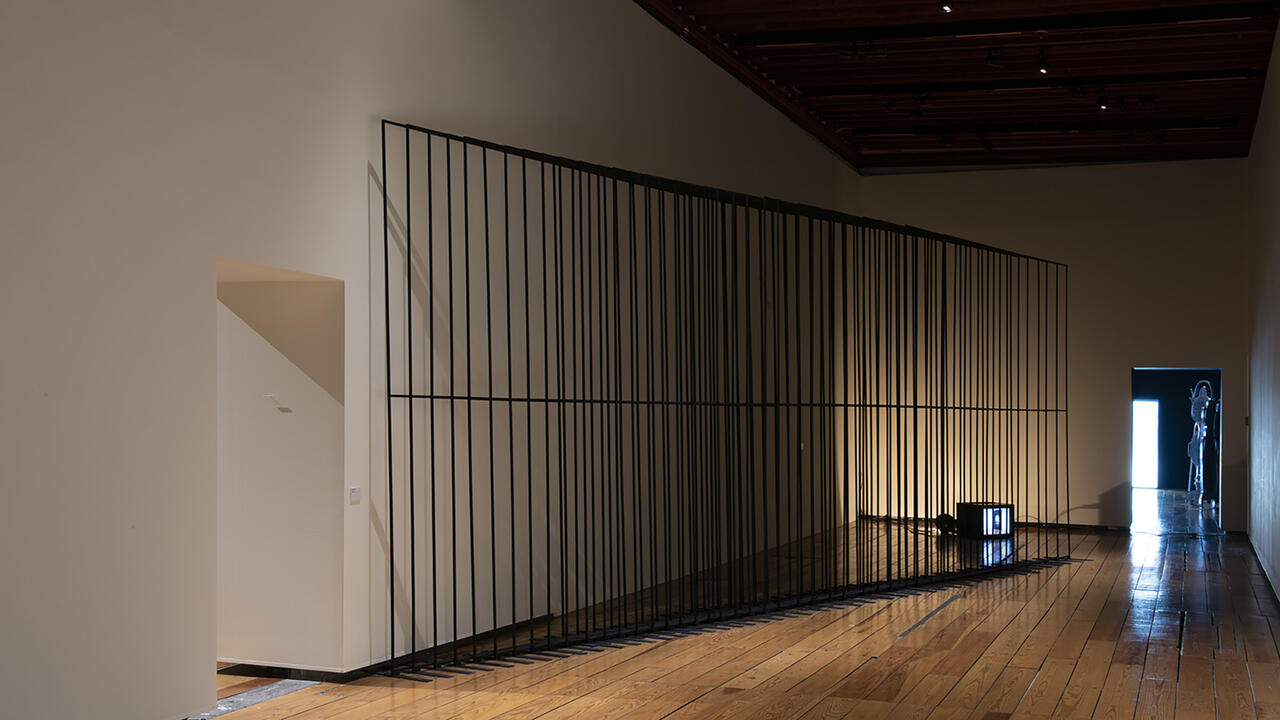Digital Dandy
Michael Riedel records, copies and repeats whatever he can get his hands on and combines the material to create austere and ironic works
Michael Riedel records, copies and repeats whatever he can get his hands on and combines the material to create austere and ironic works

In the introduction to his book Art After Appropriation (2001), John C. Welchman discusses Georges Bataille’s essay on the Marquis de Sade – The Use Value of D.A.F. de Sade (An Open Letter to My Current Comrades) from 1930. Here, Welchman notes, Bataille correlates appropriation with bodies; Bataille identifies ‘two polarized human impulses: excretion and appropriation’, which result from ‘the division of social facts into religious facts […] on the one hand and profane facts […] on the other’. Excretion is associated with the heterogeneous expulsion of foreign bodies: with ‘sexual activity […] heedless expenditure […] certain fanciful uses of money’ and ‘religious ecstasy’. Appropriation, by contrast, finds its ‘elementary form’ in ‘oral consumption’; its process ‘is thus characterised by a homogeneity (static equilibrium) of the author of the appropriation, and of objects as a final result’. Appropriative experience may begin with the ordering of foreign bodies through digestive incorporation, but it extends to analogous forms of additive material: ‘clothes, furniture, dwellings, and instruments of production […]’. ‘Such appropriations’, Bataille continues, ‘take place by means of a more or less conventional homogeneity (identity) established between the possessor and the object possessed’. But in Bataille’s opinion, there is no binary separation, because ‘production can be seen as the excretory phase of a process of appropriation’1. Appropriation is not separated from production but rather one of its possible manifestations.

The work of Michael Riedel (born in 1972) is rooted in the long history of appropriation strategies in art. Throughout a career spanning almost 15 years, Riedel has adopted different modalities of appropriation (recording, quoting, copying, doubling, inverting) and used a wide range of media (works on canvas and fabric, films, videos, audio recordings, artist books, posters, installations, events). Historically, appropriation strategies – from Marcel Duchamp to the Pictures Generation – have been linked to questions regarding originality, authorship and authority. Yet Riedel has also devoted his attention to the process of producing, labelling, branding and distributing since his studies at Frankfurt’s Städelschule (1997–2000). In a very early work that took the form of a lecture Signetismus (1997), he wrote his name on a paper bag, adding an ‘S.’ between his first and last name. At the end of the lecture, he pulled the bag over his head and said: ‘I’m Michael Riedel’. By labelling himself as a brand with a slight alteration (Michael S. Riedel), he stressed the economic and commercial character of his role as an artist.2
As a result, Riedel soon adopted entrepreneurial and business-like activities as part of his creative strategies. In 2000, he and fellow artist Dennis Loesch launched a collaborative project called Oskar-von-Miller-Straße 16. The space, named after the Frankfurt address where it was located, hosted different events with the common strategy of re-staging and re-producing already existing ones. Readings, film screenings, art exhibitions and music concerts were sometimes presented shortly after the actual event had taken place elsewhere in the city. These imperfect copies – with multiple omissions and mistakes – eventually created a curious delay effect in the perception of reality.

Clu(b)bed Club (2001–7) is another example of the ‘copy and paste’ attitude. This series of events held at Oskar-von-Miller Straße 16 consisted of audio-recordings (another favourite tool in Riedel’s passion for appropriation) which documented the nights that Riedel and Loesch spent at different clubs. Dance music, ambient noises and conversations were diffused in their Frankfurt space, while parts of the architecture of the original clubs were occasionally borrowed or specifically made as replicas, thus creating the false and cheap illusion of being part of a cool and entertaining experience which actually took place somewhere else.
Early on, Riedel used appropriative strategies in the art world with both deadpan humour and a renewed institutional critique. In 2001, he and fellow artist Achim Lengerer entered Galerie Michael Neff in Frankfurt during a Jeppe Hein exhibition, which featured two large white moving walls, activated by motion sensors. Hiding inside two cardboard boxes poorly painted white, the two artists mimicked the movements of Hein’s walls in a humorous way which added a more human, even pathetic, gesture to the Danish artist’s mechanical apparatus. In a meta-discursive moment, Riedel involved Hein in a sort of repartee on issues of Institutional Critique while using an absolutely non-technological tool.
Neo Rauch’s 2005 exhibition at David Zwirner gallery in New York became a bigger target of Riedel’s irony. For his own first solo exhibition at the same gallery a few months later, Riedel photographed and reprinted Rauch’s works. The printouts were subsequently cut into multiple sections and mounted on MDF panels, so that each image could be re-arranged in different configurations, somewhat like a puzzle. By calling his show Neo (‘new’ in Latin), Riedel once more played with the expectations of the market for new products and with his own desire to produce the minimum possible amount of new information and images.
Repeating and copying does not necessarily involve iconic moments of art or high-brow cultural production. Riedel seems attracted by the banal, marginal and in-between: background noises and chit-chat have a prominent position in his world as a black and white replica of the world around him. Banal conversations overheard between art installers in a gallery or among crowds at an opening are recorded, transcribed and printed; they turn into books and posters which function as art works and as an imprecise kind of documentation. Here, language is treated more as a visual material than as a carrier of meaningful messages. Words – at times barely readable, cut and pasted, blanked out, shifted from one context to another – become a sort of verbal white noise, a form of visual poetry for the digital age, a monument to the constant twittering in our media-scape.3 As Michel Foucault – citing Samuel Beckett – asked in his famous lecture on the author, Riedel seems to be asking (but probably with more pessimism): ‘What difference does it make who is speaking?’ 4 While Roland Barthes predicted the death of the author in favour of the birth of the reader, Riedel appears to follow a more nihilist and disillusioned path. Barthes’s emancipated ‘reader’ becomes an inattentive ‘hearer’ in Riedel’s work and in today’s technological scenarios.
It should be clear from these examples that neither romantic drives nor humanistic hopes are at play in Riedel’s idea of art and creative labour. His practice seems to follow a well-established German tradition whereby the artist’s gestures closely resemble the impersonality, repetitiveness and cold detachment of the machine, albeit with a touch of irony. Take the Pop-Minimalism of Peter Roehr or Thomas Bayrle and the dialogue they established with industrial production’s modes of reproduction and repetition. In music, consider the pivotal example of Kraftwerk with the robot-like look, repetitive electronic sounds and lyrics focused on technological and media landscape. While these examples refer to the industrial forms of production proper to Taylorism and Fordism, Riedel belongs to a generation of artists who became familiar with the Internet in the mid-1990s along with the digitization of the production, distribution and consumption of images and sounds. In the German culture of the early 1960s, the detachment of Pop and Minimal art represented an antidote to romantic and existential forms of expression and could be seen as a manifestation of a new confidence in progress and welfare after the moral and material destruction of WWII. Riedel’s motivations are different. His withdrawal from most intentional decisions in the art-making process – his productive modalities, where personal and expressive choices are reduced to a minimum or based on a set of pre-defined rules – can be seen as the latest product in a long tradition of Minimal and Conceptual gestures. But the targets of his interventions are the conditions of production, diffusion and distribution in the digital era. As the artist himself said, the Oskar-von-Miller project and others must be ‘read as a process, not as a product’. 5 In our current media-scape – saturated with an increasing number of new images and products, more and more easily produced, transmitted and dispersed – Riedel’s impersonal attitude, his Bartleby-like ‘I would prefer not to’ approach to reality, can be read as a critical form of resistance which produces new images, forms and sounds, but in the smallest possible amount.
At the same time, his compulsive attitude to repetition could be interpreted as a new form of dandyism. Detachment from personal and intimate forms of expression, a repetitive set of creative gestures, recurring codes in the appearance of the art works (totally black and white until 2007 with a rare use of colour afterwards), abstention from physical labour, a refusal to produce something ‘new’ – these are perhaps the tools used by today’s ‘digital dandy’ to express his discomfort and critical stance towards reality.6

This attitude goes with a subtle, two-fold form of narcissism, evident in a recent series of works. For his solo exhibition in 2011 at Zwirner The quick brown fox jumps over the lazy dog, Riedel presented so-called ‘poster paintings’ and ‘Power-Point paintings’. Once again, he uses pre-determined rules and quasi-mechanical actions which detach the final result from any possible expressivity, even if the content of these works is the artist, his public persona. To create backgrounds for these works, the artist searched for his name online, used the ‘select-all’ function and then copied and pasted the material onto the canvases. Divorced from a graphically-designed layout, the words appear in a linear, yet nonsensical, order and include algorithmic commands, search keywords and links. Any reference to a personal position is obliterated in an undifferentiated verbal white noise; any residual desire of self-expression is reduced to graphic motives which recall economic charts and statistics.
For his show at Frankfurt’s Schirn Kunsthalle from June to September 2012, Riedel applies his appropriative strategies to the exhibition’s title Kunste zur Text (Arts on Text, a pun on the magazine Texte zur Kunst) as well as to the Schirn’s previous show Edvard Munch. The Modern Eye. The walls from the Munch blockbuster will lean on the walls of Riedel’s exhibition space and be decorated with wallpaper which bears a pattern made with the source code of the Schirn website announcing Riedel’s show. While this gesture reflects on the artworld and the representation of himself in it, the anticipation of the show becomes part of its form, merging expectations with reality. Once again, Riedel demonstrates the fluidity and continuity of production, distribution and consumption. Our digital world recalls exchange in an oral culture of storytelling: any form of production can go through many transformations; any product is a temporary expression of a chain of incarnations which are almost indifferent to hierarchies. Bataille linked appropriation to oral consumption, but production in today’s technological-social scenario is getting closer to the excretory phase of orality.
- The opening paragraph and footnote corrected from the original version, amended 14 April 2014.
1 Georges Bataille, La valeur d’usage de D.A.F. de Sade (Lettre ouverte à mes camarades actuels), in Œuvres complètes, II, Écrits postume 1922–1940, Paris, 1972, p. 61–2, as quoted by John C. Welchman in the introduction to Art After Appropriation (2001; Routledge, London, 2003) pp. 8–9
2 The artist signed his exhibitions and art works as ‘Michael S. Riedel’ until 2007 when he sold the ‘S.’ as a drawing to a collector who included it in his own name.
3 On Riedel’s use of language, see Marcel Bugiel, Stop Making Sense, in SAAB 95 (2007)
4 Michel Foucault, Qu’est-ce qu’un auteur?, lecture at the Société française de philosophie, 22 February 1969
5 Quoted from Riedel’s lecture at The Kitchen, New York, 8 May 2010
6 Many works are based on the existence of a circle of friends or create one. Take Freitagsküche (Friday Kitchen, 2004–ongoing), a project involving communal dinners at Oskar-von-Miller-Straße 16 in Frankfurt and later in Berlin. The dandy protects himself from the external world by creating a small community, possibly to control the risk of dispersion and alienation in a digital world. In Riedel’s practice, this sense of community is a counterpart to the nihilistic alienation from personal expression described above.














